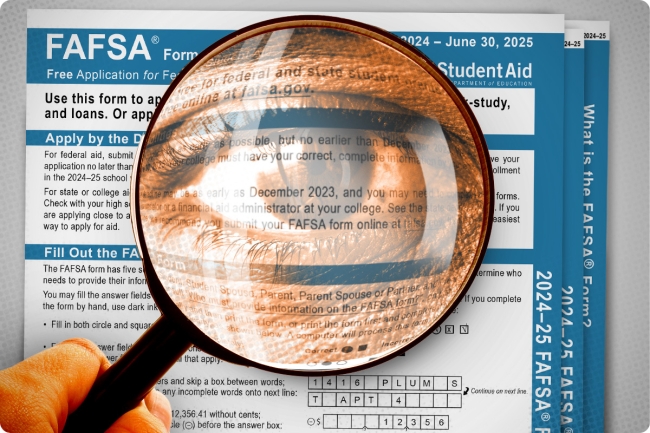You have /5 articles left.
Sign up for a free account or log in.

For financial aid and college-access professionals, a new report on the troubled FAFSA rollout is as validating as it is revealing.
Photo illustration by Justin Morrison/Inside Higher Ed | sdominick/Getty Images | Ake/rawpixel
Nine months ago, Kiely Fletcher, admissions director and vice president of enrollment management at the University of Illinois at Chicago, woke up to some disconcerting news: Processing for student federal aid forms, a crucial precursor to colleges’ financial aid packaging procedures, would be delayed by months, throwing her entire spring schedule into disarray.
As the rollout of the new Free Application for Federal Student Aid continued stumbling along, the gut punches kept coming, from further processing delays to calculation errors that added to her office’s substantial workload. Fletcher said she and her peers felt blindsided almost every week by a new setback. She wondered whether they were as surprising to the department as they were to her.
So she was both dismayed and relieved to read about findings from a Government Accountability Office investigation, detailed in a congressional hearing Tuesday, that appeared to confirm her worst fears. The GAO found that the department “failed to meet promised deadlines and provide colleges with sufficient notice of changes” throughout the application cycle.
“It felt like we were being gaslit by the department,” Fletcher said. “This report confirmed a lot of our suspicions that there was no way they couldn’t know.”
For those on the institutional side of the FAFSA crisis, the report has brought some clarity to a chaotic and confusing year.
It felt like we were being gaslit by the department.”
—Kiely Fletcher, University of Illinois at Chicago
“The whole thing was like one long bad dream,” said Brad Barnett, director of financial aid and scholarships at James Madison University. “The hearing really validated a lot of what we in the financial aid world were going through … it basically codifies that no, we weren’t imagining this—things really were that bad.”
The flip side, Barnett added, is that the Education Department’s failures are now more stark. He was particularly disappointed to learn that the department knew it would likely have to delay the launch in August 2022, yet it waited seven months to announce it.
“It’s a little disheartening to find out there was so much going on behind the scenes that we didn’t know about,” Barnett said. “There was clearly a chance to be more transparent that [the department] didn’t capitalize on.”
Kim Cook, CEO of the National College Attainment Network, said the report’s findings also reflected the experiences of college-access professionals at state agencies and nonprofit organizations who helped students and families—often low-income, first-generation applicants—navigate the rollout.
The GAO report found that in the first five months after the FAFSA launch, four million of 5.4 million calls to the Education Department’s call center went unanswered, a jaw-dropping figure that explained the difficulties NCAN members reported while troubleshooting forms for students.
“People would be on hold for hours,” Cook said. “Often they’d schedule meetings with students or parents who needed help filling out the form, only to spend the entire time on hold.”
Learning From the Past
After a grueling year spent responding to lawmakers’ scrutiny and public anger, the Education Department is charting an optimistic course through the next FAFSA cycle. The department delayed the launch of this year’s form from Oct. 1 to Dec. 1 to put it through rigorous testing, something they failed to do before last cycle’s rollout.
They’ve also worked to partially restructure the Office of Federal Student Aid, which is responsible for the FAFSA, in hopes of improving project oversight, according to a memo written last week by FSA interim chief operating officer Denise Carter and obtained by Inside Higher Ed.
Barnett is using this transitional period, while the dust from last year’s FAFSA is settled and before the cycle begins again next month, to reflect on what JMU’s financial aid office could have done better. On Friday he’ll meet with his team for a FAFSA debrief, where they’ll take stock of their approach to the FAFSA debacle and formulate a plan for the year ahead.
I want to look ahead, but we need to learn from the past.”
—Brad Barnett, James Madison University
He said the chances of an improved rollout this year hinge on the department’s willingness to do the same.
“I want to look ahead, but we need to learn from the past to make the future better,” Barnett said. “I hope the department is doing something similar right now … This testing period [in October] is the time for them to gain back some of the trust they destroyed over the past year.”
Cook said she felt reassured by the department’s approach to the 2025–26 FAFSA thus far. The first phase of testing, which begins next Tuesday, includes six scholarship and access organizations, five of which are NCAN members, and from what she’s heard, the department has been far more proactive and transparent in communicating about the rollout.
“The [GAO] report is a reminder of where we were five months ago,” Cook said. “My inbox is a reminder of where we are now.”
Fletcher, whose institution is participating in phase two of the FAFSA testing through partnerships with Chicago high schools, said she’s working with department representatives to facilitate lines of feedback on the new form in the lead-up to the Dec. 1 launch.
“Our anticipation is that we’ll be more of a full partner with the department,” she said. “I’m optimistic that this year, it won’t be a one-way street.”





